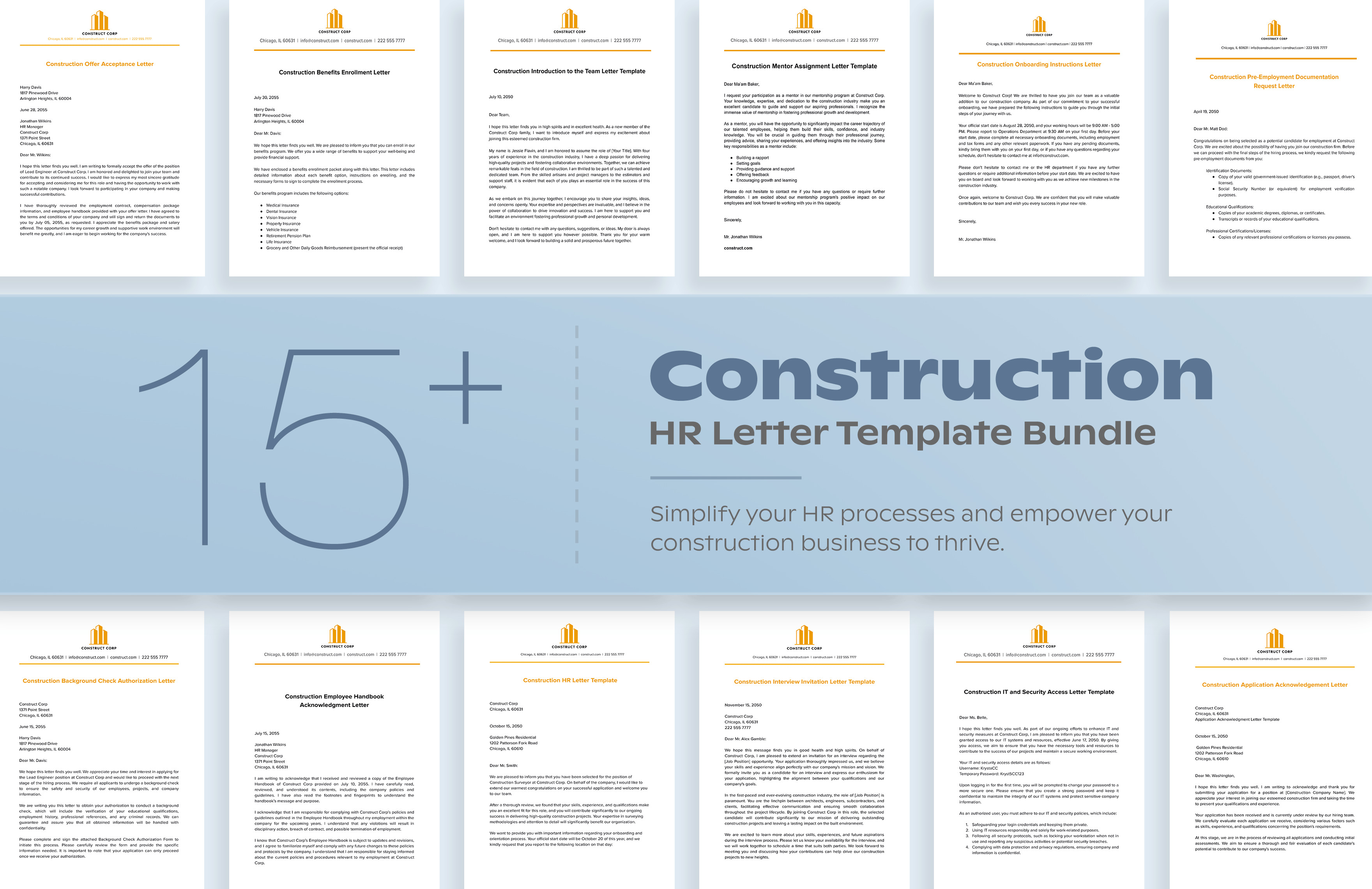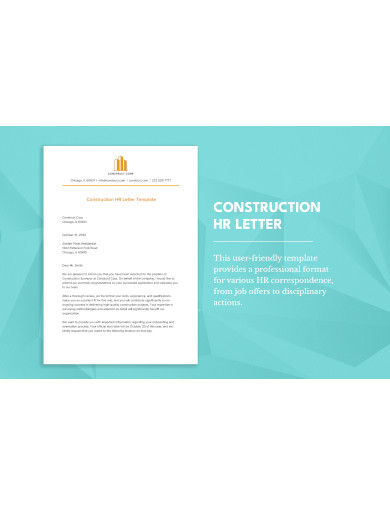In the dynamic world of construction, where every brick and beam counts, efficient communication is the bedrock of smooth operations. Our sample construction HR letter is tailored to serve the unique needs of this industry, ensuring that every human resource interaction is as solid as the structures being built. An invaluable asset to any construction business, this guide simplifies complex HR processes, fosters team alignment, and contributes to project success. Herein lies the blueprint for impeccable HR management in the construction domain.
3+ Construction HR Letter Samples
1. Letter Templates Bundle

2. Construction HR Letter Template Bundle

3. Construction HR Letter Template

What is an HR Letter of Construction?
An HR letter of construction, at its core, is a document that facilitates communication between the human resources department of a construction company and its employees, stakeholders, or even potential hires. Given the unique demands and operational intricacies of the construction industry, such letters are tailored to address issues, announcements, or updates specific to this domain.
Typically, these letters serve various purposes:
- Employee Onboarding: Welcoming new hires, outlining roles and responsibilities, and setting forth expectations for their journey within the organization.
- Regulatory and Safety Updates: Given the evolving nature of safety standards and regulations in the construction sector, HR letters can inform employees about recent changes, trainings, or mandatory compliance requirements.
- Conflict Resolution: Addressing concerns raised by employees, offering solutions, or proposing mediation for conflicts that may arise on the job.
- Recognition and Rewards: Acknowledging exceptional performance, dedication, or significant milestones achieved by teams or individual employees.
- Employment Verification: Confirming an individual’s employment status, role, duration, and other related details for external entities.
It’s imperative to note that the construction industry is heavily reliant on teamwork, punctuality, safety, and efficiency. HR letters in this sector are, thus, more than just communicative tools; they are anchors ensuring everyone is aligned with the company’s vision, goals, and operational standards.
4. Sample Construction HR Letter Template
How do I Write a Construction HR Letter?
Crafting an effective HR letter for the construction industry involves a blend of clarity, precision, and context-specific content. Here are some steps to guide you:
- Understand the Purpose: Clearly identify why you’re writing this letter. Whether it’s an announcement, a resolution, or an appreciation, the purpose should dictate the tone and content.
- Use Formal Language: Always maintain a professional tone. Avoid jargon unless it’s industry-specific and commonly understood by the recipient.
- Be Direct and Concise: Given the busy schedules in construction, it’s essential to be straightforward. Make your point without excessive embellishments.
- Include Pertinent Details: If it’s an announcement about safety training, mention the date, time, venue, and objectives. For recognition letters, detail the achievements and their impact on the project or company.
- Add a Personal Touch: Personalizing the letter, especially for recognitions or welcomes, can make the recipient feel valued. Address them by name and reference specific incidents if possible.
- End with a Clear Call-to-Action: If you expect a response or action after reading the letter, specify it clearly at the end.
- Review and Proofread: Ensure there are no grammatical errors, and the information provided is accurate and up-to-date.
Remember, the effectiveness of the letter lies not just in its content but also in its presentation. Use company letterheads, maintain a consistent format, and ensure timely delivery for maximum impact.
Do You Need a Cover Letter for a Construction Job?
When seeking employment in the construction industry, many wonder if a cover letter is necessary. The straightforward answer is: Yes, and here’s why:
- First Impressions Count: A cover letter serves as an introduction, offering potential employers a glimpse of who you are beyond your resume. It showcases your enthusiasm for the role, your understanding of the industry, and your unique selling points.
- Highlight Relevant Experience: Construction projects are diverse. A cover letter allows you to pinpoint specific projects or roles you’ve been a part of that align closely with the job you’re applying for.
- Showcase Soft Skills: The construction industry values teamwork, leadership, problem-solving, and communication. Your cover letter can highlight instances where you’ve demonstrated these skills effectively.
- Address Potential Concerns: If there’s a gap in your employment or you’re switching from a different industry, a cover letter gives you a platform to address these points proactively.
- Stand Out in a Competitive Market: With many qualified candidates vying for the same role, a well-crafted cover letter can set you apart from the crowd.
While a cover letter can be instrumental, it’s essential to keep it concise and tailored for each job application. Research the company, understand the role’s demands, and weave this knowledge into your letter. Just as every brick matters in constructing a building, every word in your cover letter counts in constructing your first impression.
Related Posts
Payment Letter Formats Samples & Templates
Business Proposal Letter to Client Samples & Templates
Company Introduction Letter Samples & Templates
Resignation Letter for Medical Samples & Templates
Letter of Intent Samples & Templates
Letter of Intent for a Job Samples & Templates
Lease Proposal Letter Samples & Templates
Letter of Inquiry Samples & Templates
Character Reference Letter Samples & Templates
Claims Letter Samples & Templates
Response Letter Sample & Templates
Follow Up Letter Samples & Templates
Sample Project Proposal Letter Templates
Donation Letter Samples & Templates
Addressing a Formal Letter Samples & Templates

